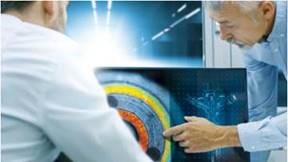Once upon a time, engineers would check the wheels of their trains simply by hitting them with a hammer and listening to the sound. If they rang like a bell – all good; if they made a dull, flat sound – they had to change it, or the whole thing could smash when in motion and cause all sorts of damage. Why? Because a crack changed the way the wheel vibrated, and vibrations cause sound.
We still use vibrations today to detect defects or confirm that an object or product behaves as expected. Today, we don’t have to rely on our own ears or even just on sound within our hearing range. There are several technologies out there that can measure vibration for us. But how do you know which technology is best for your application?
Part of our philosophy at Polytec is to make sure our customers use the right technology for their measurement challenges. Even if that is not a technology we provide, with that in mind, here are the current measurement technologies that are available today with their pros and cons:
Accelerometers
Accelerometers are very common and used in all sorts of applications – you even have them in your mobile phone. Like most types of VibrationSensors, an accelerometer directly measures acceleration (hence the name), but this information can be used to calculate the vibration of an object it is placed on.
Pros
- Inexpensive
- High accuracy in their specific measurement range
Cons
- Can cause “mass loading”. If the object you are trying to measure is light enough, the weight of the accelerometer itself can change the way it vibrates.
- If you have many points that you need to measure, using an accelerometer can be very time-consuming compared to the alternatives.
- They require direct contact to measure vibration, which is an issue in applications that are extreme temperatures (hot or cold), magnetic, radioactive, or simply out of reach.
- They need to be connected via a cable meaning directly measuring moving objects such as wheels is difficult.
Acoustic Cameras or microphone arrays
Acoustic cameras are an array of microphones, often with an optical camera in the centre. An acoustic camera can be used to calculate the frequency of vibration by recording sound pressure and by having multiple microphones a known distance from each other and from the object being measured.
Pros
- Unlike an accelerometer, this is a non-contact form of vibration measurement.
- They can measure vibrations over a wide area.
Cons
- The measurements are “fuzzy”, meaning that you can use them to identify the broad area high vibration is coming from, but they are less suitable for detailed vibration analysis.
- They are more expensive than accelerometers.
Digital Image Correlation (DIC)
Digital Image Correlation (DIC) measuring systems use an optical camera to take many images at a high resolution and at high speed. They calculate the vibration of an object by comparison of the video image from one frame to the next.
Pros
- Another non-contact option for vibration measurement.
- Can measure a wide area at once, measuring many points simultaneously.
- Better resolution than an acoustic camera
Cons
- Although the measurement itself is non-contact, the surface needs a target, such as stickers or a spray on the object being measured, to work; this is not appropriate for many applications.
- They are more expensive than accelerometers or acoustic cameras.
- Their measurement frequency range is limited due to computer and camera technology.
- Must have line of sight to work.
Vibrometers
Vibrometers, or Laser Doppler Vibrometers to give them their full name, make non-contact vibration measurements by measuring the difference between an internal reference beam and the beam pointed at the object being measured.
Pros
- A non-contact form of vibration measurement.
- Extremely accurate.
- Can be used to accurately measure very fragile surfaces – even the wing of an insect!
- As long as you can see it, you can measure it – even through glass or water and places that are difficult of hazardous to reach.
- Time efficient – can be quickly repositioned for multiple measurements.
- Surface preparation of the measurement object is not required.
- Can be used to measure surfaces that are considered difficult, such as mirrored surfaces, curved metal blades and even human skin.
Cons
- They are more expensive than accelerometers or acoustic cameras.
- Need to be able to see the measurement point either directly or via mirrors.
In short, vibrometry is the answer to many “impossible problems” in vibration measurement. If you need to measure the vibration of something and you thought it was impossible, or you simply haven’t found the answer, contact us to see if a vibrometer is your answer!
